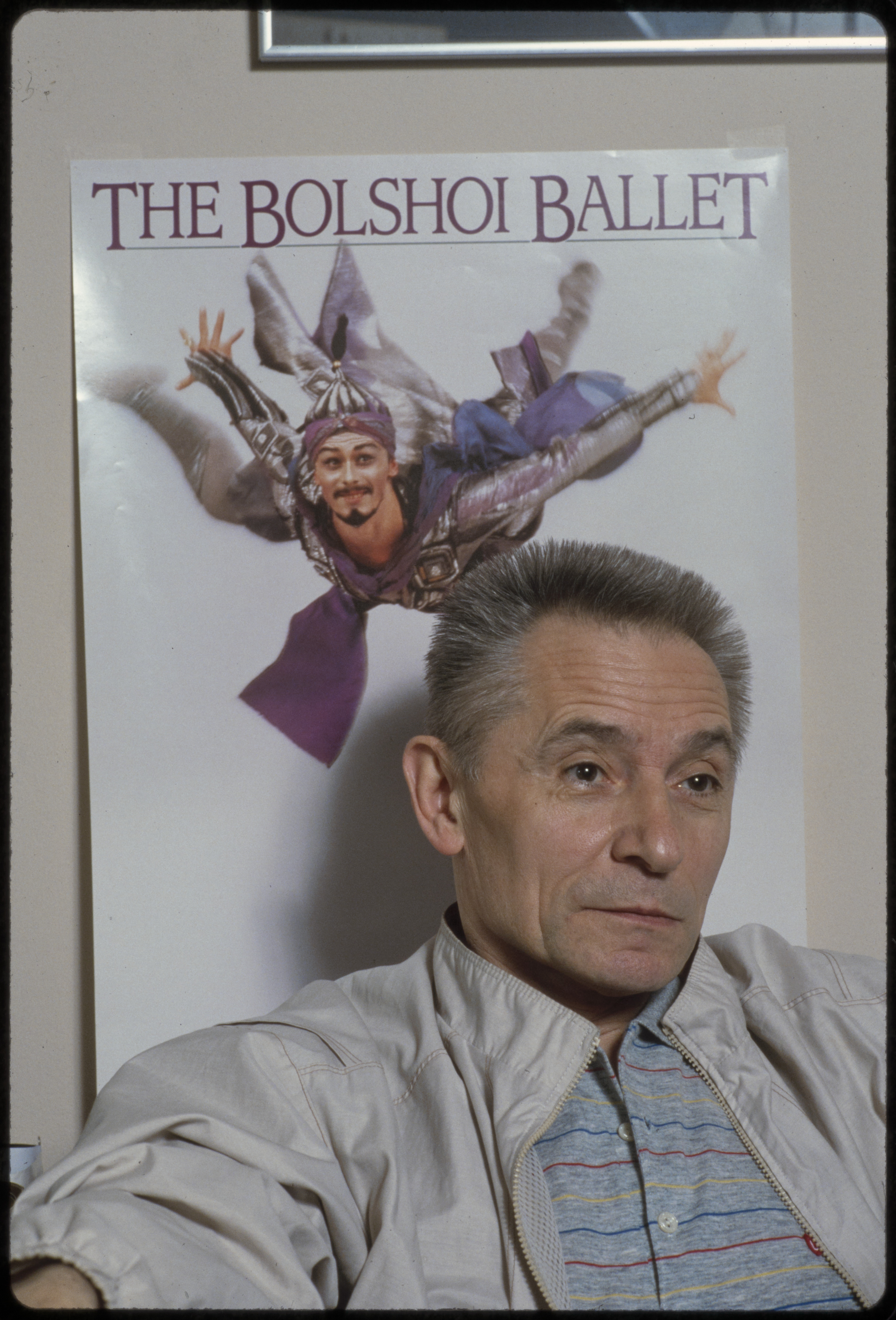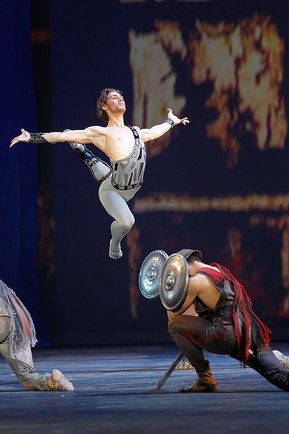|
Alla Shelest
Alla Yakovlevna Shelest (russian: Алла Яковлевна Шелест; 26 February 1919 – 7 December 1998) was a Russian ballerina, choreographer and dance director, "a star of the Kirov Ballet during the Forties and Fifties". Life and work Shelest was born in Smolensk, Russia and accepted to the Leningrad Choreographic Institute (now known as the Vaganova Academy). Her early training was by Elizaveta Gerdt but when she was older, she studied with Agrippina Vaganova. After her graduation in 1937 (where she made a huge impact dancing in the ballet ''Katerina'' by Leonid Lavrovsky), she was accepted into the Kirov Ballet and started dancing lead soloist roles almost immediately. She became known as a consummate dramatic ballerina. During World War II, to escape the Nazi siege of Leningrad, much of the Kirov Ballet, including Shelest, left for Perm in 1942. There she danced many of her leading roles for the first time, including her first Aurora in '' The Sleeping Beauty'', ... [...More Info...] [...Related Items...] OR: [Wikipedia] [Google] [Baidu] |
Citizenship Of Russia
Russian citizenship law details the conditions by which a person holds citizenship of Russia. The primary law governing citizenship requirements is the federal law "On Citizenship of the Russian Federation", which came into force on 1 July 2002. Any person born in Russia to at least one Russian parent, or born overseas to two Russian parents, receives Russian citizenship at birth. Foreign nationals may become citizens by admission after meeting a minimum residence requirement (usually five years), proving a legal source of income, and demonstrating proficiency in the Russian language. Russia previously led the Soviet Union and local residents were Soviet citizens. Following the dissolution of the Soviet Union, all post-Soviet states established separate citizenship laws. Although citizens of the former Union Republics are no longer Soviet, they continue to be eligible for a facilitated acquisition of Russian citizenship in which they can be exempted from some requirements for ... [...More Info...] [...Related Items...] OR: [Wikipedia] [Google] [Baidu] |
Vladimir Mikhailovich Zakharov
Vladimir Mikhailovich Zakharov (russian: Влади́мир Миха́йлович Заха́ров; 5 July 1946 – 14 July 2013) was a Russian choreographer, founder, Chief Choreographer and Artistic Director of Gzhel (theater), Moscow National Academic Theater of Dance Gzhel and Moscow Ballet Academy Gzhel, Ph.D. in Study of Culture, Academician, Director of the University of Dance under the Academy of Slavic Culture, People's Artist of the Russian Federation, Honoured Artist of Dagestan Republic, People's Artist of The North Ossetia-Alaniya Republic. Biography Vladimir M. Zakharov was born on 5 July 1946 in a small Russian village of Murzitsy in the Sechenovsky District. From 1960 to 1964 he studied at Choreography Department of Kaliningrad(Sovetsk-town) Regional College of Culture. After he had graduated from the college, he studied several years at Leningrad. After graduating from the Institute in 1969, he started his professional career as Chief Choreographer with Volzh ... [...More Info...] [...Related Items...] OR: [Wikipedia] [Google] [Baidu] |
1919 Births
Events January * January 1 ** The Czechoslovak Legions occupy much of the self-proclaimed "free city" of Pressburg (now Bratislava), enforcing its incorporation into the new republic of Czechoslovakia. ** HMY ''Iolaire'' sinks off the coast of the Hebrides; 201 people, mostly servicemen returning home to Lewis and Harris, are killed. * January 2– 22 – Russian Civil War: The Red Army's Caspian-Caucasian Front begins the Northern Caucasus Operation against the White Army, but fails to make progress. * January 3 – The Faisal–Weizmann Agreement is signed by Emir Faisal (representing the Arab Kingdom of Hejaz) and Zionist leader Chaim Weizmann, for Arab–Jewish cooperation in the development of a Jewish homeland in Palestine, and an Arab nation in a large part of the Middle East. * January 5 – In Germany: ** Spartacist uprising in Berlin: The Marxist Spartacus League, with the newly formed Communist Party of Germany and the Independent Social De ... [...More Info...] [...Related Items...] OR: [Wikipedia] [Google] [Baidu] |
People's Artist Of The USSR
People's Artist of the USSR ( rus, Народный артист СССР, Narodny artist SSSR), also sometimes translated as National Artist of the USSR, was an honorary title granted to artists of the Soviet Union. Nomenclature and significance The term is confusingly used to translate two Russian language titles: Народный артист СССР (fem. Народная артистка СССР), awarded in performing arts and Народный художник СССР, granted in some visual arts. Each Soviet Republic, as well as the Autonomous Republics (ASSRs), had a similar award held previously by virtually every receiver of the higher title of People's Artist of the USSR. As this title was granted by the government, honorees were afforded certain privileges and would often receive commissions from the Minister of Culture of the Soviet Union. Accordingly, artists and authors who expressed criticism of the Communist Party were seldom granted such recognition, if ... [...More Info...] [...Related Items...] OR: [Wikipedia] [Google] [Baidu] |
Maya Plisetskaya
Maya Mikhailovna Plisetskaya (russian: link=no, Майя Михайловна Плисецкая; 20 November 1925 – 2 May 2015) was a Soviet and Russian ballet dancer, choreographer, ballet director, and actress. In post-Soviet times, she held both Lithuanian and Spanish citizenship.Maya Plisetskaya profile viola.bz; accessed 2 May 2015. She danced during the Soviet era at the under the directorships of , then of Yury Grigorovich; later she moved into direct ... [...More Info...] [...Related Items...] OR: [Wikipedia] [Google] [Baidu] |
Natalia Dudinskaya
Natalia Mikhailovna Dudinskaya (russian: Ната́лия Миха́йловна Дуди́нская; , in Kharkiv – 29 January 2003, in Saint Petersburg) was a Soviet prima ballerina who dominated the Kirov Ballet from the 1930s to the 1950s. Dudinskaya's mother was Natalia Tagliori, a ballerina who had been coached by Enrico Cecchetti. Trained by Agrippina Vaganova, Dudinskaya matriculated from her school in 1931. She danced all the classical leads at the Kirov Theatre including the starring role in ''Cinderella''. She later originated leading roles in Boris Asafyev's ''Flames of Paris'' and ''Taras Bulba''. She was best known in ''La Bayadère'', ''Don Quixote'' and in the title role of the eponymous ''Laurencia'', which she originated. She was frequently partnered by her husband, Konstantin Sergeyev, famed Georgian dancer Vakhtang Chabukiani and, at the end of her career, a 21-year-old Rudolf Nureyev who she picked to partner her in ''Laurencia''. Frail health forced her to ... [...More Info...] [...Related Items...] OR: [Wikipedia] [Google] [Baidu] |
Iron Curtain
The Iron Curtain was the political boundary dividing Europe into two separate areas from the end of World War II in 1945 until the end of the Cold War in 1991. The term symbolizes the efforts by the Soviet Union (USSR) to block itself and its satellite states from open contact with the West, its allies and neutral states. On the east side of the Iron Curtain were the countries that were connected to or influenced by the Soviet Union, while on the west side were the countries that were NATO members, or connected to or influenced by the United States; or nominally neutral. Separate international economic and military alliances were developed on each side of the Iron Curtain. It later became a term for the physical barrier of fences, walls, minefields, and watchtowers that divided the "east" and "west". The Berlin Wall was also part of this physical barrier. The nations to the east of the Iron Curtain were Poland, East Germany, Czechoslovakia, Hungary, Romania, Bulgaria, Albania, ... [...More Info...] [...Related Items...] OR: [Wikipedia] [Google] [Baidu] |
Natalia Bessmertnova
Natalia Igorevna Bessmertnova (Russian: Наталья Игоревна Бессмертнова; – ) was a Soviet prima ballerina of the Bolshoi Ballet and a People's Artist of the USSR (1976). Life Natalia Bessmertnova was born in Moscow in 1941 and trained at the Moscow State Academy of Choreography from 1953-61. Among her teachers were Sofia Golovkina and Marina Semyonova. She graduated in 1961 as the first student in the school's history receiving A+ in the final examinations. In 1963, she joined the Bolshoi Ballet and was its ''prima ballerina'' for three decades. She was married to Yury Grigorovich, former Director and Chief choreographer of the Bolshoi. When he was forced to leave the Bolshoi in 1995, she took part in a historic strike which led to cancellations of scheduled performances. Bessmertnova died in Moscow on 19 February 2008, aged 66, from cancer. Her sister Tatyana (born 1947) was also a ballet dancer. Title roles * Giselle in Lavrovsky's 1963 ''Giselle'' ... [...More Info...] [...Related Items...] OR: [Wikipedia] [Google] [Baidu] |
The Tale Of The Stone Flower (Prokofiev)
''The Tale of the Stone Flower'', Op. 118 (), is Sergei Prokofiev's eighth and last ballet, written between 1948 and 1953. It is based on the Russian Ural folk tale ''The Stone Flower'' by Pavel Bazhov and is also the last of the trilogy of ballets Prokofiev wrote in the Russian ballet tradition. It was premiered posthumously in 1954, conducted by Yuri Fayer. Numbers ;Prologue: ::1 The Mistress of the Copper Mountain ::2 Danila and his work ;Act I: :Scene 1 ::3 Danila in search of the flower ::4 Danila meets some fellow villagers ::5 Scene and Duet of Katerina and Danila ::6 Interlude :Scene 2 ::7 Round Dance ::8 Katerina dances with her friends ::9 The Peasant Girls' Dance ::10 Danila's and Katerina's Dance ::11 The unmarried men's dance ::12 Severyan's Dance ::13 Altercation over the malachite vase ::14 Scene of Katerina and Danila ::15 Danila's Meditation :Scene 3 ::16 Danila enti ... [...More Info...] [...Related Items...] OR: [Wikipedia] [Google] [Baidu] |
Yuri Grigorovich
Yury Nikolayevich Grigorovich (russian: Ю́рий Никола́евич Григоро́вич; born 2 January 1927 in Leningrad) is a Soviet and Russian dancer and choreographer who dominated the Russian ballet for 30 years. Grigorovich was born into a family connected with the Imperial Russian Ballet. He graduated from the in 1946 and danced as a soloist of the until 1962. His staging of |
A Tombstone,ballerina Shelest - Panoramio
A, or a, is the first letter and the first vowel of the Latin alphabet, used in the modern English alphabet, the alphabets of other western European languages and others worldwide. Its name in English is ''a'' (pronounced ), plural ''aes''. It is similar in shape to the Ancient Greek letter alpha, from which it derives. The uppercase version consists of the two slanting sides of a triangle, crossed in the middle by a horizontal bar. The lowercase version can be written in two forms: the double-storey a and single-storey ɑ. The latter is commonly used in handwriting and fonts based on it, especially fonts intended to be read by children, and is also found in italic type. In English grammar, " a", and its variant " an", are indefinite articles. History The earliest certain ancestor of "A" is aleph (also written 'aleph), the first letter of the Phoenician alphabet, which consisted entirely of consonants (for that reason, it is also called an abjad to distinguish it fro ... [...More Info...] [...Related Items...] OR: [Wikipedia] [Google] [Baidu] |
Spartacus (ballet)
''Spartacus'' (russian: «Спартак», Spartak) is a ballet by Aram Khachaturian (1903–1978). The work follows the exploits of Spartacus, the leader of the slave uprising against the Romans known as the Third Servile War, although the ballet's storyline takes considerable liberties with the historical record. Khachaturian composed ''Spartacus'' in 1954, and was awarded a Lenin Prize for the composition that same year. It was first staged in Leningrad on 27 December 1956, as choreographed by Leonid Yakobson, for the Kirov Theatre of Opera and Ballet (Mariinsky Theatre), where it stayed in repertory for many years, but only with qualified success since Yakobson abandoned conventional ''pointe'' in his choreography. Yakobson restaged his version for the Bolshoi in 1962 and it was part of the Bolshoi's 1962 tour to New York. The ballet received its first staging at the Bolshoi Theatre, Moscow in 1958, choreographed by Igor Moiseyev; however it was the 1968 production, choreograp ... [...More Info...] [...Related Items...] OR: [Wikipedia] [Google] [Baidu] |




